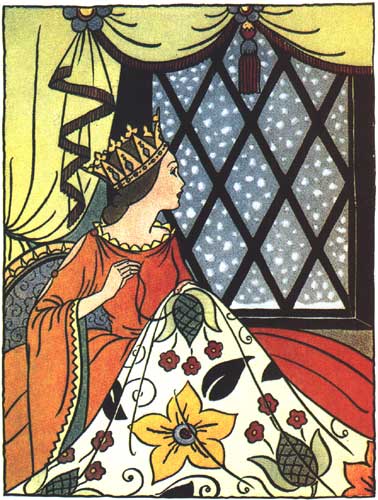|
Snow White must be a popular name in Fairytale Land. There's:
Of course, the most well-known Snow White is the one with the dwarves, and she gets her name in an unusual scene. While sewing, a queen pricks her finger and drops of her blood fall onto the snow. She remarks, “Would that I had a child as white as snow, as red as blood, and as black as the wood of the window-frame.” The resulting child is Snow White. This scene appears often in other fairytales. The Grimms also collected a Cinderella variant, beginning “A beautiful Countess had a rose in one hand and a snowball in the other, and wished for a child as red as the rose, and as white as the snow. God grants her wish.” In a Snow White variant, a count and countess are driving in the countryside. They pass three heaps of white snow, three pits full of blood, and three black ravens. What the pits of blood were doing there I have no idea. In this tale it is the husband who wishes for a girl “white as snow, red as blood, and with hair as black as the ravens,” and she instantly appears. The jealous countess tries to get rid of her, which segues into the more well-known Snow White story. In A Hundred and One Nights from North Africa (not to be confused with A Thousand and One Nights), King Sulayman ibn ‘Abd al-Malik sees two ravens fighting in his courtyard. This causes him to wonder, “Did God ever create a girl with skin as white as this marble, with hair as black as those ravens and with cheeks as red as their blood on the marble floor?” (The answer is yes. He finds her.) Similar incidents with a dying black-feathered bird against white marble or snow appear in “The Crow" (from Italy), "La princesse aux trois couleurs" (from Brittany) and "The Snow, the Crow and the Blood" (from Ireland). In "The King of Spain and the English Milord" from Italy, there's a maiden "as white as ricotta and rosy as a rose." In the Italian tale of “The Three Citrons,” a prince cuts his hand slicing ricotta cheese and decides he wants a wife “exactly as white and red as that cheese tinged with blood.” When trying to capture a fairy, he finds a girl as white as milk and red as a strawberry, and then a girl "as tender and white as curds and whey, with a streak of red on her face that made her look like an Abruzzo ham or a Nola salami." Not making that up. It’s strange that these violent scenes move the character’s mind to human beauty. The emphasis is on the colors being so so vivid, beautiful and significant that they cause this kind of reaction. Red represents life and passion, and white represents purity. Black is mentioned less often and is left out of some stories, but can represent death. These are the most significant colors in folklore and in some languages, and also in the early history of clothing dye. Some writers connect them to a Maiden/Mother/Crone Triple Goddess. The focus of the red blood with the pure white color can have sexual connotations and makes most analyses lean towards a girl going through her menstrual period or losing her virginity. But the colors aren’t just feminine. Although it's much rarer, they can be gender-neutral. In The Juniper Tree, a mother wishes, “ah, if I had but a child as red as blood and as white as snow.” She then gives birth to a son. In the Irish legend “Deirdre and the Fate of the Sons of Usnach,” Deirdre declares, "I can love only a man with those three colors: cheeks red as blood, hair black as a raven, and body white as snow." In the Italian tale "Pome and Peel," a young nobleman is as white as an apple's flesh, and his foster-brother is red and white like an apple peel. (Red, white and black are thematic colors throughout the tale.) These three colors were the marks of idealized beauty in many European countries, seen in descriptions throughout plays and Renaissance poetry. In Arabian poetry, the colors were for men or women. In one poem, the ideal man has “cheeks beautiful as a red rose on lily-white.” And according to another piece: “That woman is beautiful who possesses three white qualities, three black, three red; white body, teeth and the white of the eyes; black hair, eyebrows, and pupils; red lips, cheeks and gums.” The red and white coloration marks the person as beautiful and healthy. They are fair-skinned and unblemished, meaning they are upper class and don't work outside much, but not sickly pale. That poetry example lays out exactly what is supposed to be red and what is supposed to be white. The standard of beauty is someone with nice skin, clear eyes and healthy teeth. Sources
Text copyright © Writing in Margins, All Rights Reserved
0 Comments
Leave a Reply. |
About
Researching folktales and fairies, with a focus on common tale types. Archives
July 2024
Categories
All
|
Writing in Margins

 RSS Feed
RSS Feed
